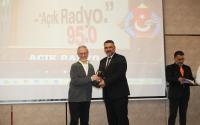3 May 2006William J. Broad
The Bush administration is seeking to develop a powerful ground-based laser weapon that would use beams of concentrated light to destroy enemy satellites in orbit.
The largely secret project, parts of which have been made public through Air Force budget documents submitted to Congress in February, is part of a wide-ranging effort to develop space weapons, both defensive and offensive. No treaty or law forbids such work.
The laser research was described by federal officials who would speak only on the condition of anonymity because of the topic's political sensitivity. The White House has recently sought to play down the issue of space arms, fearing it could become an election-year liability.
Indeed, last week Republicans and Democrats on a House Armed Services subcommittee moved unanimously to cut research money for the project in the administration's budget for the 2007 fiscal year. While Republicans on the panel would not discuss their reasons for the action, Congressional aides said it reflected a bipartisan consensus for moving cautiously on space weaponry, a potentially controversial issue that has yet to be much debated.
The full committee is expected to take up the budget issue today.
The laser research is far more ambitious than a previous effort by the Clinton administration nearly a decade ago to test an antisatellite laser. It would take advantage of an optical technique that uses sensors, computers and flexible mirrors to counteract the atmospheric turbulence that seems to make stars twinkle.
The weapon would essentially reverse that process, shooting focused beams of light upward with great clarity and force.
Though futuristic and technically challenging, the laser work is relatively inexpensive by government standards — about $20 million in 2006, with planned increases to some $30 million by 2011 — partly because no weapons are as yet being built and partly because the work is being done at an existing base, an unclassified government observatory called Starfire in the New Mexico desert.
In interviews, military officials defended the laser research as prudent, given the potential need for space arms to defend American satellites against attack in the years and decades ahead. "The White House wants us to do space defense," said a senior Pentagon official who oversees many space programs, including the laser effort. "We need that ability to protect our assets" in orbit.
But some Congressional Democrats and other experts fault the research as potential fuel for an antisatellite arms race that could ultimately hurt this nation more than others because the United States relies so heavily on military satellites, which aid navigation, reconnaissance and attack warning.
In a statement, Representative Loretta Sanchez, a California Democrat on the subcommittee who opposes the laser's development, thanked her Republican colleagues for agreeing to curb a program "with the potential to weaponize space."
Theresa Hitchens, director of the Center for Defense Information, a private group in Washington that tracks military programs, said the subcommittee's action last week was a significant break with the administration. "It's really the first time you've seen the Republican-led Congress acknowledge that these issues require public scrutiny," she said.
In a statement, the House panel, the Armed Services Subcommittee on Strategic Forces, made no reference to such policy disagreements but simply said that "none of the funds authorized for this program shall be used for the development of laser space technologies with antisatellite purposes."
It is unclear whether the Republican-controlled Congress will sustain the subcommittee's proposed cut to the administration's request, even if the full House Armed Services Committee backs the reduction.
The Air Force has pursued the secret research for several years but discussed it in new detail in its February budget request. The documents stated that for the 2007 fiscal year, starting in October, the research will seek to "demonstrate fully compensated laser propagation to low earth orbit satellites."
The documents listed several potential uses of the laser research, the first being "antisatellite weapons."
The overall goal of the research, the documents said, is to assess unique technologies for "high-energy laser weapons," in what engineers call a proof of concept. Previously, the laser work resided in a budget category that paid for a wide variety of space efforts, the documents said. But for the new fiscal year, it has moved under the heading "Advanced Weapons Technology."
In interviews, Pentagon officials said the policy rationale for the arms research dated from a 1996 presidential directive in the Clinton administration that allows "countering, if necessary, space systems and services used for hostile purposes."
In 1997, the American military fired a ground-based laser in New Mexico at an American spacecraft, calling it a test of satellite vulnerability. Federal experts said recently that the laser had had no capability to do atmospheric compensation and that the test had failed to do any damage.
Little else happened until January 2001, when a commission led by Donald H. Rumsfeld, then the newly nominated defense secretary, warned that the American military faced a potential "Pearl Harbor" in space and called for a defensive arsenal of space weapons.
The Starfire research is part of that effort.
Federal officials and private experts said the antisatellite work drew on a body of unclassified advances that have made the Starfire researchers world-famous among astronomers. Their most important unclassified work centers on using small lasers to create artificial stars that act as beacons to guide the process of atmospheric compensation.
When astronomers use the method, they aim a small laser at a point in the sky close to a target star or galaxy, and the concentrated light excites molecules of air (or, at higher altitudes, sodium atoms in the upper atmosphere) to glow brightly.
Distortions in the image of the artificial star as it returns to Earth are measured continuously and used to deform the telescope's flexible mirror and rapidly correct for atmospheric turbulence. That sharpens images of both the artificial star and the astronomical target.
Unclassified pictures of Starfire in action show a pencil-thin laser beam shooting up from its hilltop observatory into the night sky.
The Starfire researchers are now investigating how to use guide stars and flexible mirrors in conjunction with powerful lasers that could flash their beams into space to knock out enemy satellites, according to federal officials and Air Force budget documents.
"These are really smart folks who are optimistic about their technology," said the senior Pentagon official. "We want those kind of people on our team."
But potential weapon applications, he added, if one day approved, "are out there years and years and years into the future."
The research centers on Starfire's largest telescope, which Air Force budget documents call a "weapon-class beam director." Its main mirror, 11.5 feet in diameter, can gather in faint starlight or, working in the opposite direction, direct powerful beams of laser light skyward.
Federal officials said Starfire's antisatellite work had grown out of one of the site's other military responsibilities: observing foreign satellites and assessing their potential threat to the United States. In 2000, the Air Force Research Laboratory, which runs Starfire, said the observatory's large telescope, by using adaptive optics, could distinguish objects in orbit the size of a basketball at a distance of 1,000 miles.
Another backdrop to the antisatellite work is Starfire's use of telescopes, adaptive optics and weak lasers to track and illuminate satellites. It is considered a baby step toward developing a laser powerful enough to cripple spacecraft.
Col. Gregory Vansuch, who oversees Starfire research for the Air Force Research Laboratory, said in an interview that the facility used weak lasers and the process of atmospheric compensation to illuminate satellites "all the time." Such tests, Colonel Vansuch emphasized, are always done with the written permission of the satellite's owner.
He said that about once a month, Starfire conducted weeklong experiments that illuminate satellites up to 20 times.
Though the House subcommittee recommended eliminating all financing next year for antisatellite laser research, it retained money for other laser development. Congressional aides said the proposed cut to the Air Force's $21.4 million budget request for such work would eliminate two of three areas of development, for a total reduction of $6.5 million.
At least one public-interest group has seized on the issue. Last week, the Global Network Against Weapons and Nuclear Power in Space, based in Brunswick, Me., said that if Congress approved the antisatellite money, "the barrier to weapons in space will have been destroyed."






